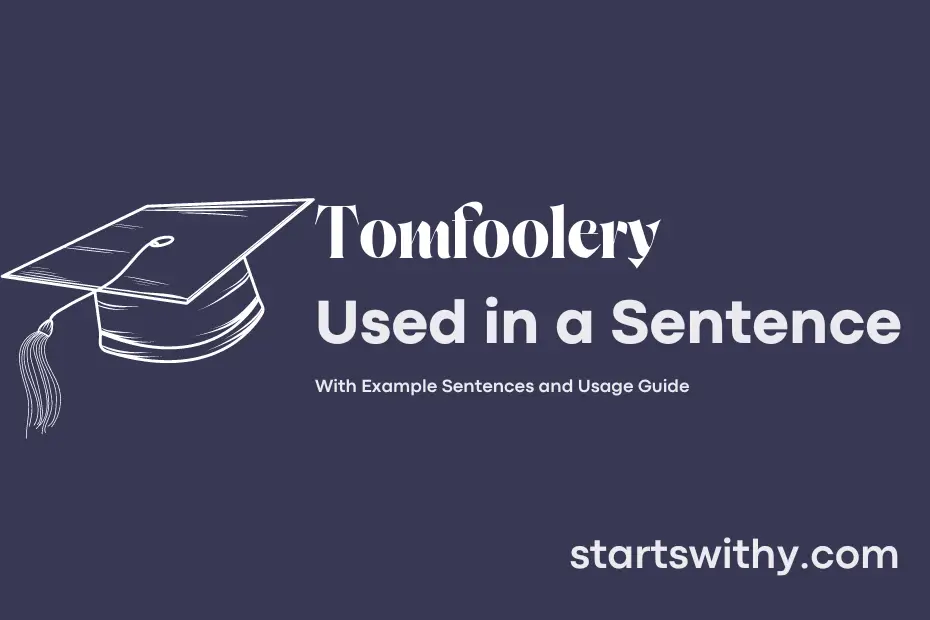Ever wondered what “tomfoolery” really means? This quirky word refers to silly or foolish behavior, often done for the amusement of others.
Tomfoolery can manifest in various forms, from playful pranks to harmless jokes, showing a lighthearted and mischievous side of someone’s personality. Let’s delve into the world of tomfoolery and explore how it adds a touch of fun and whimsy to everyday interactions.
7 Examples Of Tomfoolery Used In a Sentence For Kids
- Tomfoolery is when someone does something silly for fun.
- We shouldn’t engage in tomfoolery during class time.
- Playing pranks on friends is a form of tomfoolery.
- Let’s have a silly day filled with lots of tomfoolery!
- Remember to always be safe when you’re participating in tomfoolery.
- It’s important to know the difference between harmless fun and tomfoolery that can hurt others.
- Sometimes, a little bit of tomfoolery can make everyone laugh and have a good time!
14 Sentences with Tomfoolery Examples
- Tomfoolery during college events often leads to entertaining memories.
- Some students engage in tomfoolery to lighten the mood during exam season.
- Late-night study sessions sometimes result in tomfoolery to release tension.
- The seniors organized a hilarious talent show filled with tomfoolery.
- In class, the professor had to put a stop to the tomfoolery happening in the back row.
- The campus pranksters were known for their elaborate tomfoolery.
- Group projects can sometimes lead to tomfoolery if not managed properly.
- During college fests, you can always expect some level of tomfoolery happening.
- The sports team engaged in friendly tomfoolery during practice sessions.
- Tomfoolery at college parties often makes for amusing stories later on.
- The comedy club on campus always has a crowd roaring with laughter at their tomfoolery.
- Friends often resort to tomfoolery to cheer up a stressed-out classmate.
- Tomfoolery in the form of silly dares is a common sight among college students.
- Hanging out in the college cafeteria usually involves a fair amount of tomfoolery.
How To Use Tomfoolery in Sentences?
Tomfoolery can add a fun and light-hearted touch to your sentences. When using Tomfoolery, make sure to do so in a playful or humorous context. For example, “Despite their serious demeanor, they couldn’t help but engage in a little Tomfoolery during the meeting.” This adds a sense of merriment to the situation.
Remember that Tomfoolery should be used sparingly and appropriately for the right effect. It can be a great way to lighten the mood or inject some humor into your writing or conversation. For instance, “His Tomfoolery always managed to make everyone in the room laugh.”
When using Tomfoolery, consider the tone and audience you are addressing. It’s important to ensure that your choice of words aligns with the overall message you want to convey. Incorporating Tomfoolery into your language can be a creative way to make your point in a more light-hearted manner.
In conclusion, Tomfoolery serves as a tool to bring a sense of amusement or playfulness to your sentences. Just remember to use it wisely and in appropriate situations to enhance your communication. So go ahead, sprinkle some Tomfoolery into your language and have fun with your words!
Conclusion
In conclusion, tomfoolery refers to silly or playful behavior that is often meant to amuse or deceive others. It can be seen in various situations, such as jokes, pranks, or witty remarks that are intended to entertain or provoke laughter. While tomfoolery can be harmless and good-natured, it can also sometimes cross the line into inappropriate or disruptive behavior.
It is important to recognize the distinction between playful tomfoolery and more negative forms of mischief or deceit. By understanding the nuances of tomfoolery, we can better appreciate the role it plays in social interactions and humor, while also being mindful of when it may be inappropriate or offensive.



